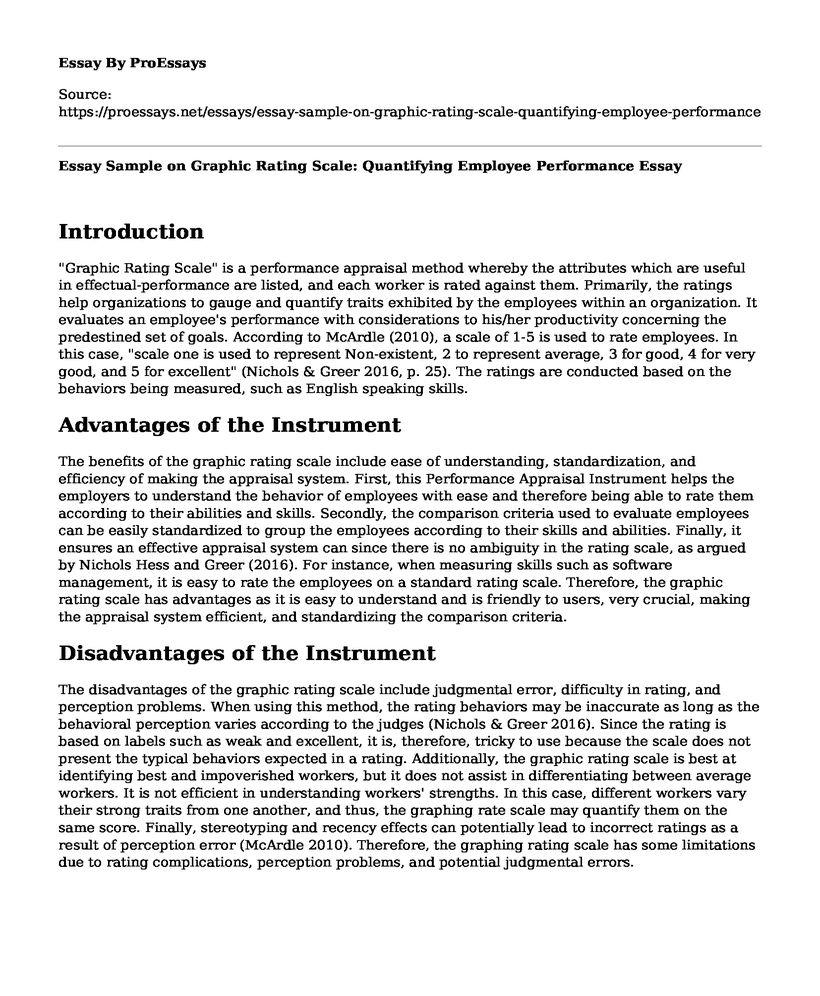Introduction
"Graphic Rating Scale" is a performance appraisal method whereby the attributes which are useful in effectual-performance are listed, and each worker is rated against them. Primarily, the ratings help organizations to gauge and quantify traits exhibited by the employees within an organization. It evaluates an employee's performance with considerations to his/her productivity concerning the predestined set of goals. According to McArdle (2010), a scale of 1-5 is used to rate employees. In this case, "scale one is used to represent Non-existent, 2 to represent average, 3 for good, 4 for very good, and 5 for excellent" (Nichols & Greer 2016, p. 25). The ratings are conducted based on the behaviors being measured, such as English speaking skills.
Advantages of the Instrument
The benefits of the graphic rating scale include ease of understanding, standardization, and efficiency of making the appraisal system. First, this Performance Appraisal Instrument helps the employers to understand the behavior of employees with ease and therefore being able to rate them according to their abilities and skills. Secondly, the comparison criteria used to evaluate employees can be easily standardized to group the employees according to their skills and abilities. Finally, it ensures an effective appraisal system can since there is no ambiguity in the rating scale, as argued by Nichols Hess and Greer (2016). For instance, when measuring skills such as software management, it is easy to rate the employees on a standard rating scale. Therefore, the graphic rating scale has advantages as it is easy to understand and is friendly to users, very crucial, making the appraisal system efficient, and standardizing the comparison criteria.
Disadvantages of the Instrument
The disadvantages of the graphic rating scale include judgmental error, difficulty in rating, and perception problems. When using this method, the rating behaviors may be inaccurate as long as the behavioral perception varies according to the judges (Nichols & Greer 2016). Since the rating is based on labels such as weak and excellent, it is, therefore, tricky to use because the scale does not present the typical behaviors expected in a rating. Additionally, the graphic rating scale is best at identifying best and impoverished workers, but it does not assist in differentiating between average workers. It is not efficient in understanding workers' strengths. In this case, different workers vary their strong traits from one another, and thus, the graphing rate scale may quantify them on the same score. Finally, stereotyping and recency effects can potentially lead to incorrect ratings as a result of perception error (McArdle 2010). Therefore, the graphing rating scale has some limitations due to rating complications, perception problems, and potential judgmental errors.
How It Helps With the ADDIE Model
The graphic rating scale, in connection with Analyzing, Designing, Developing, Implementing, and Evaluating ADDIE, helps the employers to create effective training programs within their organizations. Clark (2010) explains the importance of adopting training programs as a result of "training fads and fiction." for instance, when there is a disparity in the workers' performance, analysis becomes the assessment of the skilled and unskilled employees. On the other end, design, development, and implementation are contained in the processing of new training programs, as cited in Nichols and Greer (2016). Eventually, the evaluation of further training is reflected in the ability and willingness of employees to meet the expected performances according to the predetermined objectives of the organization.
References
Clark, R. C. (2010). "Evidence-Based Training Methods: A Guide for Training Professionals." Alexandria, VA: ASTD.
McArdle, G. (2010). "Instructional Design for Action Learning." New York. AMACOM.
Nichols Hess, A., & Greer, K. (2016). Designing for Engagement: Using the ADDIE Model to Integrate High-impact Practices into an Online Information Literacy course. Communications in information literacy, 10(2), 6.
Cite this page
Essay Sample on Graphic Rating Scale: Quantifying Employee Performance. (2023, Feb 27). Retrieved from https://proessays.net/essays/essay-sample-on-graphic-rating-scale-quantifying-employee-performance
If you are the original author of this essay and no longer wish to have it published on the ProEssays website, please click below to request its removal:
- Factors That Enhance Multicultural Communication for Virtue Teams Paper Example
- Paper Example on Finance and Strategic Management
- Leadership Interview Paper Example
- Understanding Forecasting in Business Essay Example
- Research Paper on Leadership Models: Navigating Diversity and Complexity in Organizations
- Paper Example on My HRM Journey: From Class Leader to Professional Manaager
- Essay Example on Flawed Strategic Plan Led to Poor Decision-Making in Business







